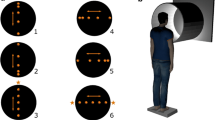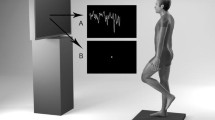Abstract
Purpose
The aim of this study was to evaluate whether different types of visual feedback influence the control of standing balance.
Methods
Twenty-six subjects performed three tasks on a force platform: (1) standing with eyes open; (2) maintaining the own center of pressure (COP) displacement (internal feedback) on a target; and (3) pointing with a handheld laser pointer (external feedback) on a target. The COP and ankle displacements were measured through a force platform and a biaxial electrogoniometer, respectively, during 60 s in each task. Global posturographic parameters were computed in the anterior–posterior and medial–lateral directions. In addition, the standard deviation and mean frequency of the ankle movements were also calculated in the sagittal plane.
Results
The sway area and standard deviation of COP differed between conditions, wherein smaller and higher values were typically observed during the internal and external feedback, respectively. Conversely, both the mean frequency and the mean velocity of COP were greater during internal feedback compared with other tasks, while external feedback usually leads to smaller values. Additionally, smaller and higher values for the ankle standard deviation and the ankle mean frequency, respectively, were observed during internal feedback, with the external feedback condition showing an opposite behavior.
Conclusions
These results showed that the global postural sway and the postural adjustments at ankle during standing balance change depending on the type of visual feedback information.



Similar content being viewed by others
Abbreviations
- AP:
-
Anterior–posterior
- COP:
-
Center of pressure
- EO:
-
Eyes open
- EXTVF :
-
External visual feedback
- INTVF :
-
Internal visual feedback
- SD:
-
Standard deviation
- ML:
-
Medial–lateral
References
Anker LC, Weerdesteyn V, van Nes IJ, Straatman H, Geurts AC (2008) The relation between postural stability and weight distribution in healthy subjects. Gait Posture 27:471–477
Balasubramaniam R, Riley MA, Turvey MT (2000) Specificity of postural sway to the demands of a precision task. Gait Posture 11:12–24
Benjuya N, Melzer I, Kaplanski J (2004) Aging-induced shifts from a reliance on sensory input to muscle cocontraction during balanced standing. J Gerontol A Biol Sci Med Sci 59:166–171
Boudrahem S, Rougier PR (2009) Relation between postural assessment with eyes open and centre of pressure visual feedback effects in healthy individuals. Exp Brain Res 195:145–152
Bronner S, Agraharasamakulam S, Ojofeitimi S (2010) Reliability and validity of a new ankle electrogoniometer. J Med Eng Technol 34:350–355
Carpenter MG, Frank JS, Winter DA, Peysar GW (2001a) Sampling duration effects on centre of pressure summary measures. Gait Posture 13:35–40
Carpenter MG, Frank JS, Silcher CP, Peysar GW (2001b) The influence of postural threat on the control of upright stance. Exp Brain Res 138:210–218
Cawsey RP, Chua R, Carpenter MG, Sanderson DJ (2009) To what extent can increasing the magnification of visual feedback of the centre of pressure position change the control of quiet standing balance? Gait Posture 29:280–284
Danna-Dos-Santos A, Degani AM, Zatsiorsky VM, Latash ML (2008) Is voluntary control of natural postural sway possible? J Mot Behav 40:179–185
Dault MC, de Haart M, Geurts AC, Arts IM, Nienhuis B (2003) Effects of visual center of pressure feedback on postural control in young and elderly healthy adults and in stroke patients. Hum Mov Sci 22:221–236
Day BL, Steiger MJ, Thompson PD, Marsden CD (1993) Human body motion when standing: implications for afferent control of lateral sway. J Physiol 469:479–499
Duarte M, Freitas SM (2010) Revision of posturography based on force plate for balance evaluation (article in Portuguese). Rev Bras Fisioter 14:183–192
Duarte M, Zatsiorsky VM (2002) Effects of body lean and visual information on the equilibrium maintenance during stance. Exp Brain Res 146:60–69
Freitas SM, Duarte M (2012) Joint coordination in young and older adults during quite stance: effect of visual feedback of centre of pressure. Gait Posture 35:83–87
Gatev P, Thomas S, Kepple T, Hallett M (1999) Feedforward ankle strategy of balance during quiet stance in adults. J Physiol 514:915–928
Haddad JM, Rietdyk S, Claxton LJ, Huber JE (2013) Task-dependent postural control throughout the lifespan. Exerc Sport Sci Rev 41:123–132
Halická Z, Lobotková J, Bučková K, Hlavačka F (2014) Effectiveness of different visual biofeedback signals for human balance improvement. Gait Posture 39:410–414
Horak FB, Nashner LM (1986) Central programming of postural movements: adaptation to altered support-surface configurations. J Neurophysiol 55:1369–1381
Horak FB, Frank J, Nutt J (1996) Effects of dopamine on postural control in parkinsonian subjects: scaling, set, and tone. J Neurophysiol 75:2380–2396
Hwang IS, Huang CT, Cherng RJ, Huang CC (2006) Postural fluctuations during pointing from a unilateral or bilateral stance. Hum Mov Sci 25:275–291
Kiemel T, Zhang Y, Jeka JJ (2011) Identification of neural feedback for upright stance in humans: stabilization rather than sway minimization. J Neurosci 31:15144–15153
Litvinenkova V, Hlavacka F (1973) The visual feed-back gain influence upon the regulation of the upright posture in man. Agressologie 14:95–99
Loram ID, Kelly SM, Lakie M (2001) Human balancing of an inverted pendulum: is sway size controlled by ankle impedance? J Physiol 532:879–891
Mitra S, Fraizer EV (2004) Effects of explicit sway-minimization on postural-suprapostural dual-task performance. Hum Mov Sci 23:1–20
Morrison S, Keogh J (2001) Changes in the dynamics of tremor during goal-directed pointing. Hum Mov Sci 20:675–693
Nardone A, Schieppati M (2010) The role of instrumental assessment of balance in clinical decision making. Eur J Phys Rehabil Med 46:221–237
Oliveira LF, Simpson DM, Nadal J (1996) Calculation of area of stabilometric signals using principal component analysis. Physiol Meas 17:305–312
Park E, Schöner G, Scholz JP (2012) Functional synergies underlying control of upright posture during changes in head orientation. PLoS One 7:e41583
Pei L, Li H, Fu Y, Tang Y (2011) Influences of visual feedback indicator scales on human upright postural control. CYBER 6011803:249–253
Prieto TE, Myklebust JB, Hoffmann RG, Lovett EG, Myklebust BM (1996) Measures of postural steadiness: differences between healthy young and elderly adults. IEEE Trans Biomed Eng 43:956–966
Riley MA, Stoffregen TA, Grocki MJ, Turvey MT (1999) Postural stabilization for the control of touching. Hum Mov Sci 18:795–817
Runge CF, Shupert CL, Horak FB, Zajac FE (1999) Ankle and hip postural strategies defined by joint torques. Gait Posture 10:161–170
Sayenko DG, Alekhina MI, Masani K, Vette AH, Obata H, Popovic MR, Nakazawa K (2010) Positive effect of balance training with visual feedback on standing balance abilities in people with incomplete spinal cord injury. Spinal Cord 48:886–893
Stoffregen TA, Smart LJ, Bardy BG, Pagulayan RJ (1999) Postural stabilization of looking. J Exp Psychol Human Percept Perform 25:1641–1658
Taube W, Leukel C, Gollhofer A (2008) Influence of enhanced visual feedback on postural control and spinal reflex modulation during stance. Exp Brain Res 188:353–361
Van Peppen RPS, Kortsmit M, Lindeman E, Kwakkel G (2006) Effects of visual feedback therapy on postural control in bilateral standing after stroke: a systematic review. J Rehabil Med 38:3–9
Vieira TM, Baudry S, Botter A (2016) Young, healthy subjects can reduce the activity of calf muscles when provided with EMG biofeedback in upright stance. Front Physiol 7:1–12
Visser J, Carpenter MG, Van der Kooij H, Bloem B (2008) The clinical utility of posturography. Clin Neurophysiol 119:2424–2436
Winter DA, Prince F, Frank JS et al (1996) Unified theory regarding A/P and M/L balance in quiet stance. J Neurophysiol 75:2334–2343
Wulf G (2013) Attentional focus and motor learning: a review of 15 years. Int Rev Sport Exerc Psychol 6:77–104
Acknowledgments
The authors are grateful to the volunteers for their cooperation. This work was supported by a Grant from the Coordenação de Aperfeiçoamento de Pessoal de Nível Superior (CAPES) and FAPERJ. T.L. was recipient of a CAPES-PNPD fellowship.
Author information
Authors and Affiliations
Corresponding author
Ethics declarations
Conflict of interest
The authors declare no conflicts of interest, financial or otherwise.
Additional information
Communicated by Toshio Moritani.
Rights and permissions
About this article
Cite this article
dos Anjos, F., Lemos, T. & Imbiriba, L.A. Does the type of visual feedback information change the control of standing balance?. Eur J Appl Physiol 116, 1771–1779 (2016). https://doi.org/10.1007/s00421-016-3434-7
Received:
Accepted:
Published:
Issue Date:
DOI: https://doi.org/10.1007/s00421-016-3434-7




